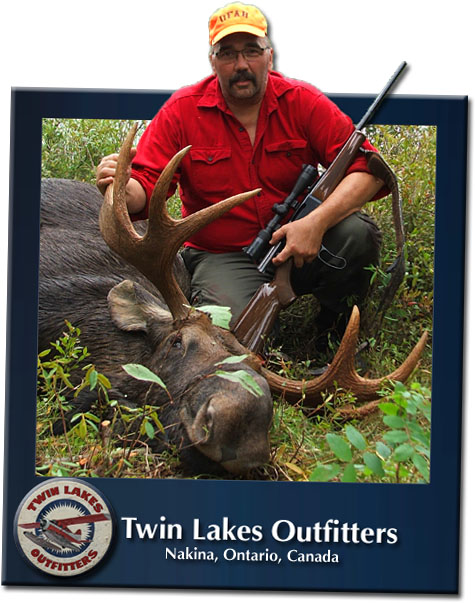



 For the experienced or novice moose hunter alike, nothing compares to an isolated moose camp to optimize their chance for a successful hunt, as well as provide surroundings of exceptional natural beauty.
For the experienced or novice moose hunter alike, nothing compares to an isolated moose camp to optimize their chance for a successful hunt, as well as provide surroundings of exceptional natural beauty.
One way to ensure a private, secluded hunt, and have a large portion of the planning, accommodations and equipment provided for you, is to take part in a fly-in trip, the likes of which Twin Lakes Outfitters can provide.
The following text will provide a general overview of moose and moose hunting which will hopefully include information for the well-schooled hunter as well as newcomers to the sport.
Moose:
The name moose is derived from the Algonkian name meaning "eater of twigs". Moose are the largest of the deer family with seven different sub-species recognized in the world, four of which inhabit North America. They are the Alaskan, Shiras, and the two which inhabit Ontario, the Eastern and Northwestern moose.
The Alaskan moose is considered the largest of the family, with bulls weighing in at 1800lbs, with a comparable Eastern bull generally never weighing over 1400lbs.
Moose are generally the size of a horse, with long ears, humped shoulders, an elongated head and a "dewlap" or bell hanging from the throat. Their "gangly", awkward appearance is deceiving as it suits the diverse environment which they inhabit and allows them to travel over any type of terrain. They are capable of running as fast as 35 mph. and can swim or climb steep hills with equal ease. Although their eyesight is relatively weak, they certainly aren't blind, but their most acute sense is that of hearing which is aided by their "donkey like" ears that help the animal to pick up even minute sounds at great distances.
Below is some general information specific to the Eastern moose, the type most prevalent in Ontario.
• Calves: Birthweight - approx. 30 lbs. Weight at 1/2 year - male 350 lbs. female - 330 lbs.
• Adults: maximum weight - male- 1200 lbs female - 850 lbs.
• Maximum age: captive - 20-25 years wild - 15 years
• Mating: mid September to mid October
• Gestation: 240-245 days
Habitat:
For the most part, moose habitat is generally quite diverse including swampy areas as well as mixed forested higher ground. Summer will find them feeding more on aquatic vegetation, while during the fall season their diet shifts to include more leaves and shoots of hardwood trees and shrubs. Fresh or second growth areas are a favorite during the fall. Moose will still enjoy frequenting spots around lakes and swamps where yellow marsh "hay" is abundant.
Generally speaking, an area which includes both young trees and swampy lakes would be considered prime moose country.
Movement:
During the summer, moose tend to spend most of their time within one or two square miles of "home territory". This begins to change somewhat during the fall, where bulls tend to be the greater wanderer, traveling up to 4 miles from their "home" area in search of a suitable mate.
Antler Development:
On bulls, antlers begin to grow early in the summer until their maximum size is reached by late August. Up until this point the antlers were covered by a "velvet" which now begins to have a reduction in blood flow causing the covering to gradually peel off, resulting in the more polished, bone like structure seen in the fall.
In the winter, sometime between December and March / April the antlers are shed and the process begins anew.
 The Hunt:
The Hunt:
Moose hunting, like all big game hunting, requires a good deal of preparation and planning, as well as all the necessary equipment.
A Fly -in trip with TWIN LAKES OUTFITTERS eliminates a large portion of equipment needs, as comfortable accommodations, heating and cooking utensils, boats motors & gas, and transportation to the hunt camp from our Air Base are all provided. As these issues are taken care of for individuals on such a trip, only the more personal hunting equipment and supplies will be advised upon below:
Personal Gear: When planning for a trip such as this, great attention must be paid to detail, while not going overboard. A comprehensive list of needed gear should be compiled and include the following hunting equipment:
1. Gun, ammunition and sling
2. Knives
3. Thermos
4. Binoculars
5. Compass or GPS
6. Moose call
7. Small chain saw
The large size of a moose dictates that a suitable caliber rifle be used. The rifle should be one which maximizes your potential opportunities while minimizing the animals unnecessary suffering or loss.
Many caliber's are considered suitable for hunting moose, as long as they have the necessary power for a clean kill. A heavier bullet is recommended for game the size of a moose, as it is the bullets weight which influences penetration and expansion. This will, of course, lead to somewhat less velocity, producing poorer trajectory, but, in turn produces more shocking power at relatively shorter ranges, thereby being more effective for game as large and as tough as the moose.
Below is a chart of popular moose caliber's and bullet weights.
CALIBER - BULLET - WEIGHT
• .30/06 - SPRINGFIELD - 180
• .308 - WINCHESTER - 180
• 7mm - REM. MAGNUM - 175
• .300 - WINCHESTER MAGNUM - 180
• .300 - WEATHERBY MAGNUM - 180
• 7mm - WEATHERBY MAGNUM - 150
As well it is advisable that moose rifles be equiped with a telescopic sight. Quite often shots are made which are relatively long. Shots more than 300 yards are realistically not advisable as the trajectory drops off significantly for most caliber's after that range. Scopes should be calibrated so that they are accurate,( dead on ), at 200 yards. This will allow for an effective shot anywhere from 0 to 300 yards, well within the approximate 8 inch radius of the kill zone.
Clothing:
Clothing required for a moose hunt should be a good cross section, diverse enough to make one comfortable in temperatures ranging from fairly cool, (freezing ), to possibly quite warm. Wool outer clothing is preferable, as it is considerably quieter than synthetics and has the ability to provide warmth even when wet. A good set of raingear and hunter orange outer wear is a necessity.
General Gear:
• FLASHLIGHT
• MEAT-SAW
• COME-ALONG
• ROPE
• CHEESECLOTH
• FIRST AID KIT
• ALARM CLOCK
• TOPOGRAPHIC MAPS
This list is specific to "shared" items and necessary equipment which need not be duplicated within the group, but should be included specifically for use should a moose be harvested.

Hunting Techniques:
1. There are essentially two primary methods used for hunting moose, still hunting and stand hunting.
Still hunting is a technique where the individual, keeping the wind in their favour, walks slowly and quietly in and around areas of plentiful sign. The best time for this type of hunting is after a heavy rain when leaves and underbrush are soaked and it is quieter to move around.
2. The second method for hunting moose, and probably the most popular, is stand hunting. This requires positioning yourself in a favourable area over which you can watch without being detected.
Before the hunt, it is advisable to scout out prospective locations by looking for areas of fresh droppings tracks, recently eaten brush or other telltale signs of frequent moose activity. Once a promising area has been determined, the hunter will find a suitable location to stay put comfortably for long hours, from which he or she can observe the area.
Calling is certainly an addition to stand hunting that will greatly increase it's effectiveness, but it is something that should be practiced and perfected before being used in the field. Although there are a number of sounds or calls made by moose for communication, the primary one used by hunters during the rut is the cow call or mating call. This essentially is mimicking an available cow in order to attract a prospective bull. During the rut, which peaks between mid September to mid October, is when calling can be most effective.
Although the bulls are actually seeking cows continually through the rutting period, the cows are only sexually receptive a few days out of a 28 day cycle. If no bull is responsive to her during this short period of estrus, she may, after approximately 25 days, have a second "heat". Studies have shown that the majority of conceptions are achieved in the September / October months. Because of this cycle, calling anytime during the rut can significantly increase a hunters chances of harvesting an animal, particularly a bull.
Hunting moose requires a great deal of pre-planning and patience, and while this article has touched on some of the most important issues, there are certainly more that should be considered. The role of the weather on the hunt, unfamiliar sounds and odours, and of course how to properly handle and butcher an animal after a successful hunt are a few.
Much of this information can be easily researched by talking to experienced hunters or by reading many of the detailed articles or books available, it certainly is a subject that has been well documented.
In closing, moose hunting is an enjoyable, popular pastime where one spends many hours with good friends in pleasant surroundings. If successful, it also provides hunters the chance to indulge in meat from one of the tastiest big game animals. Unfortunately with popularity, comes a certain degree of crowding, as hunters compete for the "hot spots". One certain way to thoroughly enjoy a trip without concern of pressure of other hunters is to fly-in to one of the many secluded hunting locations that Twin Lake Outfitters offers. A spot that, for a short period of time, you can call your own. Enjoy.